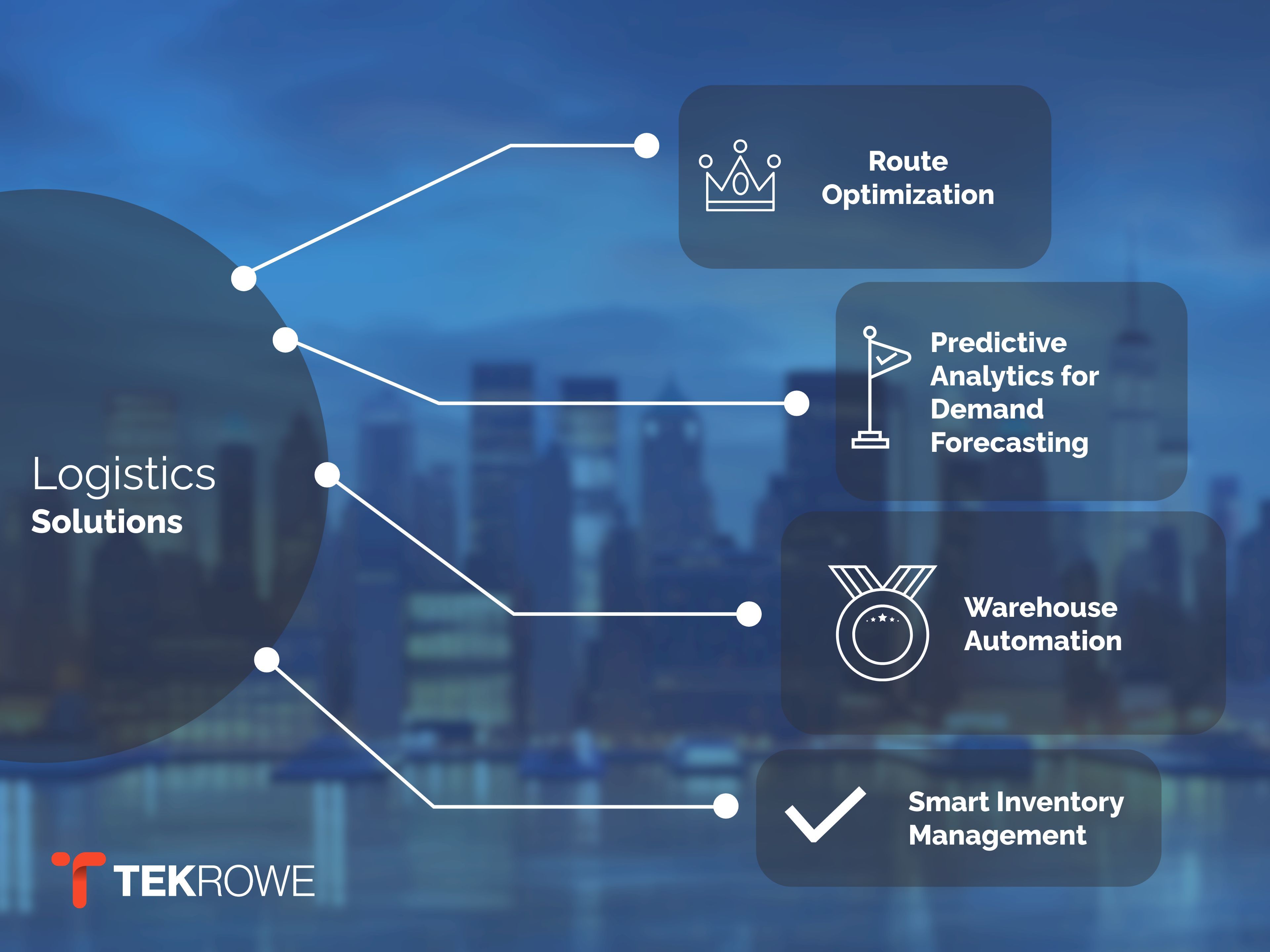In today's fast-paced world, logistics is the backbone of almost every business. Imagine if all your deliveries were always on time, routes were optimized seamlessly, and customers were consistently satisfied. Sounds like a dream, right? That's where Artificial Intelligence (AI) steps in. AI isn't just a buzzword anymore—it's the game changer logistics companies need to thrive in an increasingly competitive market. From smarter supply chain management to predictive analytics, AI is redefining the logistics industry. In fact, according to a recent report by McKinsey, logistics companies could potentially reduce costs by up to 40% using AI-powered solutions (McKinsey, 2023).
AI offers logistics companies the tools they need to adapt to a constantly shifting environment, where demands can change overnight, and efficiency is critical to staying ahead of the competition. In an age where delivery times and customer satisfaction are vital to a company’s reputation, AI is transforming the entire logistics industry. AI-driven tools enhance visibility, make operations more transparent, and improve decision-making capabilities. The adoption of AI solutions allows companies to not only meet customer expectations but to exceed them.
So, what are these AI solutions, and how can they help optimize efficiency and delivery accuracy in logistics? Let's dive deeper into this transformative technology.
Understanding AI in Logistics
What is AI in Logistics?
At its core, AI in logistics refers to the use of advanced technologies such as machine learning, IoT, robotics, and automation to streamline logistics processes. The goal? To make logistics more efficient, cut costs, and enhance delivery accuracy. Simply put, AI is like having a personal assistant who never gets tired and can handle millions of tasks simultaneously.
AI in logistics involves automating processes that were once time-consuming and prone to errors. By incorporating AI, logistics companies can ensure that each aspect of their supply chain runs smoothly—from warehouse management and inventory control to route optimization and customer service. This not only improves productivity but also helps identify potential problems before they escalate.
The Role of Artificial Intelligence in Logistics
AI is like the wizard behind the curtain—working silently, but effectively, to ensure that logistics operations run smoothly. Whether it’s automating repetitive tasks, predicting demand fluctuations, or optimizing routes, AI has numerous applications.
How AI Revolutionizes Traditional Logistics
Gone are the days when logistics managers relied solely on manual inputs. AI is transforming traditional logistics by predicting inventory needs, managing warehousing efficiently, and even responding to unforeseen disruptions more effectively. The result? Reduced costs, fewer errors, and a logistics operation that runs like a well-oiled machine.
For example, consider the impact of AI on inventory forecasting. AI can analyze historical sales data, market trends, and customer preferences to predict the demand for products. This information allows logistics companies to avoid overstocking or understocking, which can save substantial costs. The use of AI also helps in capacity planning, ensuring that the right resources are allocated where and when they are needed most.
AI in Supply Chain Management
AI plays a critical role in supply chain management as well. By predicting demand, it allows for more effective inventory management and helps reduce wastage—resulting in better profits. AI algorithms can monitor suppliers, identify inefficiencies, and help logistics managers make more informed decisions.
With AI, supply chain visibility is also improved, offering end-to-end insights that were once challenging to gather. AI enables logistics managers to access real-time information, giving them the power to anticipate problems before they happen. The result is a more resilient supply chain capable of adapting quickly to disruptions.
Key Technologies Behind AI in Logistics
AI Use Cases in Logistics
AI technologies are being applied across logistics in innovative ways that are helping businesses revolutionize their operations. Here are some specific use cases where AI is making an impact:
1. Real-Time Tracking and Monitoring
With AI, logistics companies can track shipments in real-time, which is a huge advantage for both businesses and customers. Sensors on trucks and containers, coupled with AI algorithms, provide detailed insights into the shipment's location, ensuring transparency and timely updates. This use case has significantly enhanced customer satisfaction by offering accurate delivery information.
Real-time tracking also contributes to proactive problem-solving. If a shipment is delayed due to traffic or weather conditions, AI can identify alternative routes to keep things on schedule. This level of responsiveness wasn't possible before, but AI makes it a reality.
2. Demand Forecasting
AI's ability to forecast demand helps logistics companies prepare for busy seasons and avoid bottlenecks. By analyzing historical data, seasonal trends, and even social media, AI can predict spikes in demand and allow logistics providers to allocate resources effectively. This use case ensures that inventory levels are optimized and resources are used efficiently.
Demand forecasting with AI also enables better pricing strategies. For instance, AI can detect when demand for specific goods is about to peak and adjust the pricing or promotional strategies accordingly. This predictive ability makes logistics providers proactive rather than reactive.
3. Smart Warehouse Management
AI-driven systems in warehouses are able to manage inventory autonomously, predicting when stock needs to be replenished and directing robots to retrieve items. This use case of AI ensures that warehouses are running at peak efficiency, reducing delays in order fulfillment and increasing overall productivity.
Warehouse robots work in harmony with AI algorithms to create a dynamic warehousing environment. Automated systems can even arrange goods to be stored based on their frequency of use, minimizing the time workers or robots spend searching for items. AI transforms warehousing from a static space to a highly organized, adaptive, and responsive ecosystem.
4. Predictive Maintenance
AI can analyze vehicle data and predict when maintenance is needed before a failure occurs. By employing predictive maintenance, logistics companies can keep their fleets in excellent condition and prevent costly breakdowns. This use case reduces downtime and ensures that deliveries are made on time.
Predictive maintenance is particularly valuable for large fleets, where even minor mechanical issues can have far-reaching effects. AI monitors vehicle health parameters such as tire pressure, engine temperature, and oil levels, alerting operators to address issues proactively. This practice not only reduces costs but also extends the life of the vehicles, adding further value to the business.
5. Autonomous Vehicles
The deployment of AI-powered autonomous vehicles is transforming the logistics landscape. Autonomous delivery trucks and drones are capable of transporting goods without human intervention. This use case helps in improving delivery times, reducing operational costs, and expanding the reach of logistics services into remote areas.
Autonomous vehicles are also proving to be safer and more reliable. Equipped with multiple sensors and cameras, these vehicles can navigate streets safely, detect obstacles, and avoid collisions. Autonomous vehicles are taking logistics a step closer to 24/7 operations, as they can function continuously without the need for rest breaks, which is a game changer for time-sensitive deliveries.
6. Route Optimization and Traffic Prediction
AI-based route optimization tools calculate the fastest and most efficient routes based on traffic conditions, weather, and other external factors. This use case not only helps in saving time and reducing fuel consumption but also ensures more accurate delivery timelines, enhancing customer experience.
Route optimization is crucial in urban areas, where congestion can significantly delay deliveries. AI algorithms assess real-time traffic data and provide rerouting suggestions to drivers, helping to bypass bottlenecks and avoid peak congestion periods. AI-driven optimization reduces wear and tear on vehicles while minimizing carbon emissions, contributing to a greener logistics operation.
Machine Learning Algorithms
Machine learning is the brain of AI solutions in logistics. By analyzing data, machine learning algorithms can predict optimal routes, estimate delivery times, and even anticipate delays. These algorithms keep improving as they learn from past data, making logistics operations smoother and smarter. Machine learning can even identify patterns in customer behavior, which can help logistics providers improve customer experience.
By utilizing data such as historical delivery times, driver performance, and external factors like weather conditions, machine learning algorithms can recommend better delivery routes, helping drivers avoid delays and save fuel. This not only increases efficiency but also minimizes costs and improves customer satisfaction.
Machine learning also plays a role in handling exceptions in logistics. For example, if a delivery is delayed due to unforeseen circumstances, machine learning algorithms can analyze the situation and provide recommendations to mitigate the delay. This type of decision-making capability helps logistics companies respond dynamically to challenges.
Internet of Things (IoT)
IoT devices act like the senses of AI, gathering information from all over the logistics ecosystem. Sensors in vehicles, warehouses, and containers provide real-time data that AI analyzes to make instant decisions, optimizing the entire logistics process.
IoT devices offer unparalleled visibility into supply chains. For instance, temperature sensors can ensure that perishable goods are transported under ideal conditions. AI can immediately act on information provided by IoT sensors, such as rerouting a truck if road conditions are bad or if the vehicle needs maintenance. Real-time tracking using IoT ensures that companies can monitor shipments, reduce loss or theft, and provide accurate delivery information to customers.
IoT also contributes to operational safety in logistics. Sensors can detect unsafe driving behaviors such as harsh braking, speeding, or sudden turns. AI then alerts drivers or takes corrective action to ensure safe transportation of goods. Such features enhance safety for drivers and reduce the risk of accidents, leading to better insurance terms and overall operational efficiency.
Robotics and Automation
Robotics, powered by AI, are taking over the repetitive and labor-intensive tasks in logistics. For example, autonomous forklifts in warehouses and robotic sorters in sorting facilities improve accuracy and speed—freeing up human workers for more critical tasks. Robotics helps eliminate human error, making the process more efficient and less costly.
Consider the use of autonomous mobile robots (AMRs) that can independently navigate warehouses to move goods from one point to another. AMRs are smarter than traditional conveyor belts or automated guided vehicles (AGVs) because they can reroute themselves in case of obstacles, ensuring minimal disruptions. Automated sorting systems powered by AI can also handle high volumes of packages quickly, ensuring that orders are fulfilled on time.
Robotics is also extending its capabilities to last-mile delivery. Some logistics companies are experimenting with robots that can deliver packages from the curb to the customer’s doorstep, ensuring contactless delivery. This use case has gained significant traction since the COVID-19 pandemic and is expected to continue to grow as consumers demand more convenient delivery options.
Predictive Analytics and Big Data
Predictive analytics is one of the most exciting areas of AI in logistics. By analyzing massive sets of historical data, AI can make informed predictions, like estimating peak periods or potential delays due to weather. This helps logistics companies prepare in advance, ensuring smooth delivery operations.
Big data, when coupled with predictive analytics, offers actionable insights that were previously impossible to gather manually. Logistics companies can use predictive analytics for better fleet management, anticipating maintenance needs, and understanding customer buying behavior. Predictive analytics can also help with demand forecasting, ensuring that inventory is always aligned with market demands.
Predictive analytics also enhances decision-making. By integrating data from multiple sources—such as customer preferences, traffic updates, and supplier reliability—logistics companies can make more strategic decisions. Whether it's rerouting shipments or modifying delivery schedules, predictive analytics empowers logistics managers with the foresight to make timely decisions that improve efficiency.
What Is An Example of AI in Logistics?

Warehouse Automation Using AI
Imagine a warehouse where robots pick, pack, and sort items with near-zero error rates. AI-driven automation systems can quickly determine the best path for a robot to navigate through the warehouse, ensuring efficiency. Companies like Amazon are already leading the charge in this area with their Kiva robots.
AI-powered warehouse management systems (WMS) can optimize how goods are stored, minimizing the time taken to retrieve and ship products. By utilizing algorithms that analyze order data, AI ensures that frequently picked items are stored in easily accessible locations, thereby increasing picking efficiency. This creates a seamless, efficient, and optimized warehousing experience.
AI also enables warehouses to operate 24/7 with minimal human intervention. Automated guided vehicles (AGVs) work around the clock to keep warehouse activities running smoothly. AI oversees the entire process, ensuring optimal resource allocation, reducing delays, and improving overall warehouse productivity.
Autonomous Delivery Vehicles and Drones
Self-driving delivery vehicles and drones might sound futuristic, but they are already here. Companies like UPS and FedEx are experimenting with autonomous trucks for long-haul deliveries, and drones are being used to drop off packages in remote areas—all driven by sophisticated AI algorithms. These autonomous vehicles are equipped with sensors, cameras, and machine learning algorithms that allow them to navigate streets safely.
Drones offer a unique advantage for last-mile delivery in areas where traditional vehicles might face challenges, such as heavy traffic or rough terrain. AI ensures that drones find the most efficient route and adapt to changing conditions, ensuring timely delivery even in the most challenging situations.
Drones can also be used for inventory checks in warehouses. Instead of having personnel manually check inventory, drones equipped with cameras and RFID readers can perform inventory audits quickly and accurately. This not only saves time but also reduces labor costs and minimizes human error.
Route Optimization Tools
AI-based route optimization tools are like having a GPS that not only knows the shortest route but also takes into account traffic, weather, and even road conditions. This means deliveries are made faster, cheaper, and with fewer disruptions. Route optimization is critical, especially for last-mile delivery, which often poses the most challenges in logistics.
AI tools can analyze real-time data from multiple sources—traffic reports, weather forecasts, and even social media feeds—to provide drivers with the most optimal routes. This helps in reducing fuel consumption, cutting down on delivery times, and ensuring a better experience for customers. Companies such as DHL and Route4Me are already leveraging AI-driven route optimization to provide a competitive edge.
Route optimization tools also help in reducing the environmental impact of logistics operations. By finding the most efficient routes, AI reduces fuel consumption, leading to fewer carbon emissions. This is a significant step towards making logistics operations more sustainable and eco-friendly.
Advantages of AI in Logistics
Enhanced Efficiency and Productivity
AI makes logistics operations faster and more productive. Machine learning algorithms can predict the most efficient ways to get products from point A to point B, reducing time and cost. AI's ability to automate warehouse processes, optimize delivery routes, and forecast demand results in significant productivity improvements.
AI also helps in optimizing fleet management. By analyzing vehicle data, AI can suggest better maintenance schedules, leading to reduced downtime and more efficient fleet utilization. This means that logistics companies can handle more deliveries without a proportional increase in costs.
AI-based decision-making tools also empower managers to allocate resources more effectively. Whether it's workforce allocation, fleet management, or inventory placement, AI provides the insights needed to make informed decisions, thereby boosting overall productivity.
Reducing Human Error
By automating routine tasks, AI significantly cuts down on human error. Imagine less paperwork and fewer missed shipments—AI ensures that processes are streamlined and accurate. By providing real-time information and insights, AI helps logistics staff make better decisions, further reducing the risk of mistakes.
AI can automate processes like inventory management, data entry, and customer inquiries—tasks that are often prone to human error. By reducing the need for manual intervention, AI ensures a higher level of accuracy and consistency throughout the logistics operation.
Reducing human error also translates to better safety outcomes. For instance, AI can analyze driver behavior and provide corrective feedback to prevent accidents. Predictive analytics can flag potential risks before they become major issues, contributing to a safer work environment for logistics personnel.
Cost Savings
AI helps companies save money by optimizing routes, reducing fuel consumption, and minimizing delays. It’s like finding the most cost-efficient way to run your logistics while still keeping customers happy. By optimizing warehouse operations, reducing the time spent on repetitive tasks, and increasing vehicle efficiency, logistics companies can see a significant reduction in their operational costs.
AI also enables better resource management. By predicting demand, logistics providers can reduce excess inventory, minimize wastage, and allocate resources where they are needed most. Predictive maintenance, for example, can prevent costly repairs by addressing issues before they become major problems.
In addition, AI helps reduce labor costs by automating tasks that were traditionally handled by humans. Warehouse robots, autonomous delivery vehicles, and automated customer support systems all contribute to reducing the need for manual labor, leading to considerable cost savings over time.
Delivery Accuracy and Customer Satisfaction
AI in logistics means fewer errors, faster delivery times, and greater customer satisfaction. Imagine receiving real-time alerts about your package’s status—that kind of transparency and accuracy leads to better customer trust and loyalty. AI-driven chatbots can also provide customers with instant answers to their queries, improving the overall customer experience.
AI-powered customer relationship management (CRM) tools can analyze customer feedback to identify areas for improvement. By using AI to understand customer expectations better, logistics companies can tailor their services to enhance customer satisfaction and build long-term loyalty.
AI also allows companies to personalize the delivery experience. For instance, AI can analyze customer preferences to determine the best time for delivery, making the process more convenient for the customer. Personalized experiences foster trust, leading to repeat business and higher customer retention rates.
Predictive Maintenance
AI doesn't just help with delivery. Predictive maintenance tools use AI to analyze vehicle data and anticipate maintenance needs before issues arise, preventing costly breakdowns and improving fleet uptime. Predictive maintenance is crucial for logistics companies because it ensures that their vehicles are always in top condition, leading to fewer delays and disruptions.
By analyzing data from vehicle sensors, AI can predict when a component is likely to fail and alert logistics companies to perform maintenance before it becomes a significant issue. This proactive approach not only reduces repair costs but also extends the life of vehicles and machinery.
Predictive maintenance also reduces the risk of unexpected failures, ensuring that deliveries stay on schedule. For businesses that rely on tight delivery windows, such as food and pharmaceutical logistics, predictive maintenance is a game changer that ensures critical goods reach their destination on time and in good condition.
Challenges of Implementing AI in Logistics
High Initial Costs
One of the significant barriers to adopting AI in logistics is the high upfront investment. AI technology, from sensors to software, can be expensive initially—but the long-term returns can outweigh these costs. Logistics companies need to consider the total cost of ownership, including implementation, training, and maintenance expenses.
However, many logistics companies are now seeing AI as a worthwhile investment that can provide a significant return in terms of increased efficiency and reduced operational costs. Government incentives and partnerships with technology firms can also help alleviate the burden of high initial investments.
In addition to equipment costs, there is also the cost of hiring or training personnel to manage and maintain AI systems. The skills required to implement and manage AI are specialized, and logistics companies may need to invest in acquiring this expertise.
Integration with Existing Systems
AI integration can be complex, particularly if existing systems are outdated. It requires time, effort, and expertise to ensure smooth implementation without interrupting operations. Legacy systems often need to be updated or replaced, which can be a significant challenge for companies with limited IT budgets.
Successful integration requires a strategic approach, including conducting a thorough assessment of current systems, identifying gaps, and working with technology partners to create customized solutions. Interoperability between AI and existing systems is crucial to avoid data silos and ensure seamless information flow across all logistics functions.
Another aspect of integration is the challenge of data quality. AI systems are only as effective as the data they process, and poor data quality can hinder AI's ability to deliver accurate insights. Logistics companies need to ensure their data is clean, organized, and up-to-date to get the most out of AI investments.
Overcoming Barriers: How to Adopt AI Successfully
Start Small and Scale Gradually
Logistics companies should start small, perhaps by automating one section of the warehouse before scaling across the entire operation. A phased approach allows organizations to adapt and troubleshoot along the way. Starting with smaller projects enables teams to understand AI technology better and build confidence in its benefits.
By proving success in one area, logistics companies can justify the investment required to scale AI throughout the entire organization. Whether it's route optimization, predictive maintenance, or warehouse automation, starting small and learning from initial implementations is key to long-term success.
A gradual approach also allows companies to customize AI solutions to fit their specific needs. Rather than adopting a one-size-fits-all solution, companies can use the lessons learned from initial AI projects to develop tailored solutions that address their unique logistical challenges.
Training Staff and Changing Mindsets
For AI adoption to be successful, employees must be trained and comfortable with new technologies. Building a culture that welcomes technological advancements is crucial. Training programs that educate staff on how to use AI tools effectively can help ensure a smooth transition.
It is equally important to change the mindset of employees, who may be skeptical of new technologies or fear that automation will replace their jobs. By emphasizing that AI is meant to augment human capabilities rather than replace them, companies can foster an environment where employees feel empowered rather than threatened.
Leaders play a critical role in driving the cultural change needed for AI adoption. Managers need to advocate for AI technology, demonstrate its benefits, and encourage employees to view AI as a tool that will make their work more efficient and less monotonous. This shift in mindset is key to overcoming resistance and ensuring successful AI implementation.
Need Help with Your Business
Contact Us NowFuture of AI in Logistics
Emerging Trends to Watch
The future looks bright for AI in logistics. From AI-driven customer service bots to using blockchain for more transparent supply chains, the innovations are endless. One emerging trend is the use of AI for dynamic pricing, where logistics companies can adjust rates based on supply and demand in real time.
Another trend is AI-driven sustainability. Logistics companies are increasingly using AI to optimize routes, reduce fuel consumption, and minimize carbon emissions, contributing to a greener supply chain. The combination of AI and green technologies is setting the stage for more eco-friendly logistics operations.
AI is also enabling greater personalization in logistics. Companies are using AI to analyze customer preferences and create personalized delivery options. For example, AI can determine the best delivery time based on a customer’s past behavior or recommend delivery options that best suit their needs. This trend toward personalization is making logistics more customer-centric than ever before.
The Path Ahead: Full Automation?
Are we heading towards fully automated logistics? While that future might still be a few years away, we are certainly moving in that direction. AI continues to push the boundaries, making full automation a very real possibility. Fully autonomous warehouses and driverless trucks are already in development, and it won't be long before these innovations become the norm.
However, complete automation will require overcoming several technical, regulatory, and ethical challenges. While AI can handle many logistics tasks, human oversight will still be needed to ensure that operations are efficient, safe, and adaptable to changing conditions.
One of the challenges of full automation is the lack of a regulatory framework. Governments and international bodies need to develop guidelines for the safe operation of autonomous vehicles and robots in logistics. Additionally, ethical concerns about job displacement need to be addressed to ensure that automation benefits society as a whole.
Artificial Intelligence: Paving the Way for Tomorrow's Logistics Revolution
Artificial Intelligence is transforming logistics, making it smarter, more efficient, and incredibly accurate. It’s not just about reducing costs—it's about delivering an exceptional customer experience, staying ahead of the competition, and adapting to the future of logistics. Whether it’s autonomous trucks, smart warehousing, or predictive maintenance, AI is making the logistics industry leaner and meaner. So, why wait? The future of logistics is here, and AI is leading the charge.
The benefits of AI in logistics are undeniable, but it's crucial to approach adoption strategically. Start small, invest in training, and foster a culture that embraces technological advancement. AI has the power to revolutionize logistics, but success depends on how well companies adapt, integrate, and innovate. By leveraging AI's full potential, logistics companies can set new benchmarks in efficiency, accuracy, and customer satisfaction.




